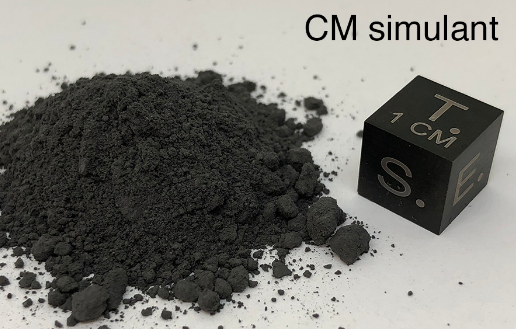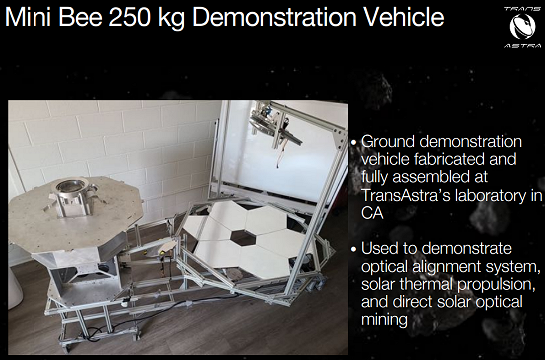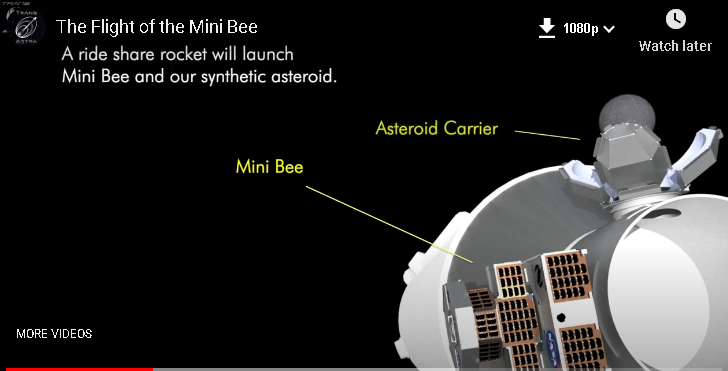OrganicMarble should get the points I guess, so this is just a partial. Also there have been updates since 2019:
I am wondering what kind of target the MiniBee is going to practice extracting water and other things from?
simulated asteroid in dried, cobble form, no details yet.
Will it use some naturally occurring debris in space, or
naturally on Earth as it happens. UCF states that raw material is available from terrestrial mine sources or chemical suppliers. (UCF supplied their previous simulants)
will some "practice targets" made of hydrated stimulants be released some distance away, or
Carried on the same launch vehicle and then deployed to test the capture system.
do they have something else in mind?
So, simulated asteroid material have been around for a while, and since 2019, with some standardized accuracy. So the latest tests probably have been based on extracting from these materials. UCF says these can be processed into different physical forms as desired.
TL;DR:
Simulated asteroid still looks like a small ball from videos, though to test the optical mining in space it may well have the properties or developed from the UCF simulated asteroid material, detailed below.
In a recent video, October 2022, they show a simulated asteroid sample again:

It might well be the same simulant used in the 2015 White Sands test (linked in comments) - UCF simulant work:

Exolith Lab
Exolith Lab enables space exploration, science, and education by making high-fidelity regolith simulants available to researchers and students around the globe.
The UCF/DSI CI Carbonaceous Chondrite Simulant (also known as UCF/DSI-CI-2) is a general purpose asteroid regolith simulant based on the Orgueil CI carbonaceous chondrite.
This material, engineered to be chemically and mechanically similar to asteroids, is based on a carbonaceous chondrite meteorite that fell in southwestern France in 1864 - Orgueil. This is one of five known meteorites belonging to the CI chondrite group. This group is notable for having a composition that is essentially identical to that of the sun.
This sample is not from the asteroid, but is based on the composition of Orgueil.
approximately 1oz (30g) of material is made up of:
Mineralogy:
Mg-serpentine: 51.3%
Magnetite: 10%
Vermiculite: 9.6%
Olivine: 7%
Pyrite: 7%
Attapulgite: 5.3%
Sub-bituminous coal: 5%
Ferrihydrite: 4.8%
In the first effort to systematically create high-fidelity asteroid simulants, the University of Central Florida (UCF) and Deep Space Industries developed a series of prototypes with physical forms including solid cobbles and regolith.
The goal of the Exolith Lab (https://sciences.ucf.edu/class/exolithlab/) is to produce and distribute a line of standardized simulants for asteroids, the Moon, and Mars
CI simulant based on the Orgueil meteorite:

CM simulant based on the Murchison meteorite:

CR simulant based on an average of five CR chondrites:

CI Simulant in appropriate dried and crushed cobbles form for grapple tests:

Compressive strengths cited for CIs are typically several MPa (megapascal strength) (similar to Styrofoam), while CMs can reach 50–100 MPa, stronger than concrete.

Mini Bee Ground Asteroid Optical Mining Demonstration
Oct 6, 2022 The TransAstra engineering team successfully demonstrates mining asteroids with Optical Mining technology using the Mini Bee Ground optical test bed in Los Angeles, CA.
https://outerspaceland.com/008-TransAstra-Space-Age-Gold-Rush.html
October 27, 2022
During my tour of The Hive (TransAstra's Los Angeles headquarters), Sercel took me to see the Mini Bee Ground System test bed set up in the back parking lot used to demonstrate Optical Mining. It had been fired up for a test on a simulated asteroid just days before my visit.

September 2021 release information:

Ground test vehicle built:

Jan 2021 - the simulated asteroid is carried with the Mini Bee at launch and then deployed.

The video suggests an optical mining test but then also says the simulated asteroid will be released after the test.
Capture bag demonstration carried out in 2021:

Simulated asteroid:
(speculation)
Maybe developed from projects such as this - highly likely given the simulant was created by the same people at University of Central Florida, where they hold the database:
https://www.spacedaily.com/reports/Engineers_published_material_standards_for_simulated_asteroid_surfaces_999.html
Mar 5, 2019
Scientists have created the world's first material standards for simulating asteroid regolith and cobble surfaces.
In the past, efforts to simulate extraterrestrial surfaces have been plagued by inconsistencies. Scientists have used a wide variety of materials -- everything from floral foam to beach sand -- to simulate the same extraterrestrial surfaces.
To test the accuracy of their new standards, engineers used them to simulate the surface of Orgueil, a meteorite that struck France in 1864. The model material featured properties with a high degree of similarity to Orgueil's actual properties.
"We're delighted we could get such a high-fidelity simulant," Metzger said. "The fact that we were able to replicate those eight properties with such high fidelity tells us that these simulants will be very valuable for companies doing asteroid mining, doing tests of constructions of facilities and landing pads, metal extraction and more."
The one shown in the Vimeo video (from comments) is from a White Sands test in 2015, an 8kw vacuum demonstration.

Video test of latest (2022) ground test for optical mining:
Mini Bee Phase 3 Demonstration Project, Year 2 - NIAC Symposium 2021
The simulated asteroid will be a lot smaller than this though, lol

https://www.flickr.com/photos/akuchling/21733039498
https://custom.cvent.com/216E523D934443CA9F514B796474A210/files/7c786128b3084611a437b60976201d5f.pdf
https://onlinelibrary.wiley.com/doi/full/10.1111/maps.13345
https://newspaceglobal.com/optical-mining-blasts-water-out-asteroid-rocks-focused-sunlight/
https://www.nextbigfuture.com/2021/04/space-telescope-design-that-will-be-400-times-better-at-finding-asteroids.html














